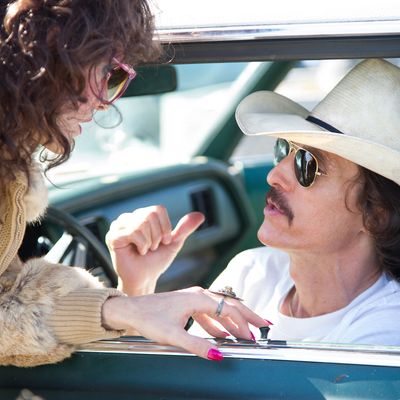
Matthew McConaughey doesn’t work to anyone else’s metronome, which might be why he looked like he was slumming in a long stretch of so-so rom-coms that made him piles of money and also a joke. I don’t think he was slumming; I think he has his own stubborn Texas timing (his dad is in the oil bidness) and wouldn’t be rushed. He had to make his lines his own. At some point, he got tired of the disrespect and started taking eccentric, lower-paying parts in indie pictures like Bernie, Killer Joe, Magic Mike, Mud, and now Dallas Buyers Club, for which he lost about a quarter of his body weight to play Ron Woodroof, the rodeo cowboy, electrician, and (hetero) sex fiend who was stricken with HIV in 1985. McConaughey’s hollows and protruding bones are scary to behold, and they serve to set off the intensity of his performance. No one will accuse him of slumming here. His Woodroof is a man who doesn’t just not want to die. He has a terror of passivity. It’s unmanly. It’s un-American. It makes a rodeo cowboy want to grab that bull by the horns.
Despite its downbeat context (a plague at its height), the movie is a crowd-pleaser—graceful and funny enough to distract you from its gaps and elisions. The Montreal-born director, Jean-Marc Vallée, clearly boned up on loose, countercultural seventies pictures like Rancho Deluxe, Payday, and Buffalo Bill and the Indians. His framing is open, his rhythm in sync with McConaughey’s—the hard-partying, good-ol’-boy hustler who happens in this case to be on the side of the angels. The movie’s main thread is Woodroof’s desperate attempt—after being told he has 30 days to live—to find alternative sources of treatment. First, he bribes a hospital orderly for AZT, which is still in trials. Then, he chances on a U.S. ex-doctor (license revoked) in a Mexican clinic who has a different, more holistic regime. Screenwriters Craig Borten and Melissa Wallack embrace the theory that high doses of AZT in the mid-eighties killed people as fast as AIDS did, and that government agencies took their cues from the pharmaceutical company rather than physicians and patients on the front lines. So Woodroof becomes a countercultural hero by bringing non-approved meds over the border and selling them out of two rooms in a ramshackle Dallas motel.
The secondary thread is the sentimental clincher: how a flagrant Texas homophobe (“[Rock] Hudson was a cocksucker! All that Hollywood pussy being wasted!”) comes to like and then stand up for the LGBT community. Woodroof’s chief ally is an alluring transvestite named Rayon, played by Jared Leto, who’d make anyone rethink his or her prejudices. It’s difficult to talk about the beauty of Leto’s performance, because he just, well, is. The transformation is so complete—physically and vocally—that it’s hard to believe he could ever be anything else. Rayon (née Raymond) is high on being Rayon, to the point where you sometimes forget that he’s dying, too. (One of the film’s best scenes is one in which Rayon dons an ill-fitting suit and tie to beg for money from his estranged father.) Vallée cites the documentary How to Survive a Plague as an inspiration for the scenes in which Woodroof, Rayon, and their allies take on the FDA (and the FBI, DEA, and IRS) to create, in effect, an alternative universe. They’ve been left with no recourse: It’s break the law or die.
The question is open whether Dallas Buyers Club plays fair. The people who rushed AZT through its trials were responding to a plague unlike any in modern history, and the drug is still—in lower doses—part of the cocktail that has kept hundreds of thousands of people alive. The filmmakers do acknowledge AZT’s role—but in an end title that comes as a shock after watching our heroes exhort AIDS sufferers to throw the drug into the toilet. (Is that title there for legal reasons?) And in the course of Woodroof’s trips around the world to procure more meds, the film doesn’t hint at the universe of quacks and scam artists selling false cures. Who ran the trials abroad? Were mortality rates lower in countries where these remedies were legal? And how reliable was Woodroof’s 30-days-to-death diagnosis to begin with? You can accept the movie’s thrust and still wonder if something has been left out.
As a doctor who’s appalled by those AZT trials, Jennifer Garner gets a lot of scenes in which she vainly challenges the physician in charge (Denis O’Hare) and then returns to her desk and fumes: Will she shut up and follow orders or throw in her lot with the outlaws? It’s not a well-shaped role, but I’ve gotten to the point where I’m happy to see Garner in anything. She’s incapable of phoniness. Griffin Dunne is irresistible—and barely recognizable—as the hairy, unkempt doctor in Mexico who’s convinced that AZT destroys everything (bad and good) in its path. Kevin Rankin shows up as another redneck sleazeball (this year alone he menaced Walt and Jesse in Breaking Bad and the free world in White House Down), this time a buddy of Woodroof’s who gets smacked down when he impugns Rayon’s humanity. It’s a scene that gladdens the heart. Who better than a macho cowboy to put a homophobe definitively in his place?
This review initially appeared in the Nov. 4, 2013 issue of New York magazine.





